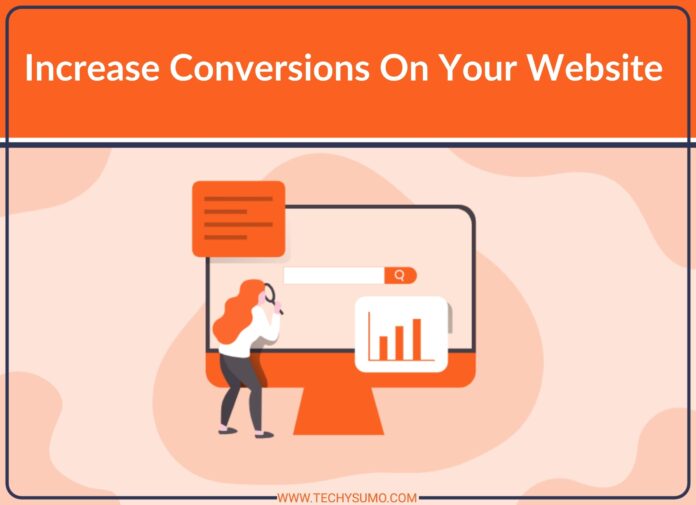Do you ever find yourself wondering why one of your website pages has so many more visitors than another?
Perhaps one page converts better than the rest, but you can’t figure out why. To help you figure it out, here are seven tips to increase conversions on your website.
Table of Contents
Conversion Rate Optimization
What is it? Why should you care? Conversion rate optimization (CRO) is all about increasing conversions. If your conversion rate—that’s conversions divided by website visitors—is 10 percent, for example, and you want to double it, then you need a plan of action. And CRO is where that happens. It’s not something that comes overnight; there are many factors involved in getting a boost in conversions: from user experience to design and copywriting. The good news is that with some research and effort, you can almost certainly improve your website’s performance with CRO tactics.
Conversion optimization is important for all types of businesses. You can generate more leads by optimizing your conversions. Read this guide for more information.
1) Keep it simple, stupid
There are three ways to increase conversions that marketers can employ. The first is by increasing click-through rates, or reducing bounce rates. The second is through conversion rate optimization, a fancy way of saying that you’re tweaking your landing page so it’s just right for converting customers. The third is called A/B testing, which involves measuring two variations of your landing page against each other and seeing which performs better.
Since not all visitors are going to respond in exactly the same way (hey, we’re not robots!), you want to test different elements of your landing page against each other before deciding what works best for you. For example, if one headline converts more users than another, but one CTA button converts fewer users than another, then you know which element should stay and which should go.
2) Use fewer calls-to-action (CTAs)

The more you have, the less impact each one has. Increasing conversions means using fewer CTAs and making them bigger and more noticeable. If your goal is for users to subscribe, make that CTA a large button placed front-and-center in your website’s navigation menu. If you want people to donate, put your donation form front-and-center or create a pop-up so it doesn’t get lost. Take some time to really think about what action you want from users, then place your call-to-action where it will do its best work. That might mean taking something away from another area of your site. And remember: All these changes are just suggestions. Only you know how many CTAs you need and where they should go, so only you can decide whether or not these suggestions are right for your business.
3) Use white space
More white space in your design means fewer distractions for visitors, leading to a better overall experience. For example, it’s very common for people to visit a website, read only half of an interesting piece of text or have trouble finding specific information because that content is surrounded by so much noise. By keeping your design simple and consistent, you can avoid these problems. If possible, use more white space around your content and remove unnecessary clutter from your page; if you need to add new elements like images or navigation items, add more blank space between them and your primary content so they don’t distract from one another. Using whitespace effectively will not only help users focus on what matters most but also make your site look more professional.
4) Make everything readable at once

It’s common knowledge that people are drawn in by pictures, but if there are several at once, it could become overwhelming and viewers may leave without clicking through. Break your page into sections (such as a header area, left column and main body), making sure each section is distinct and easily digestible. From there, make sure images complement—not compete with—the content.
A few well-placed photos or videos can entice potential customers to click through and find out more about you or your product. At any given time, users only have a short attention span; it’s up to you to keep them interested enough in your website that they’ll do what you want them to do—buy something from you!
5) Use high-quality images and videos
Images and videos are an essential part of your online marketing strategy. They have been shown to boost conversions by up to 80%! So what kind of images should you be using? For starters, try using high-quality images with a good camera or smartphone. Bright, vibrant colors will draw attention. And remember: text is okay, but context matters more. Think about how your audience might respond—and picture yourself as someone who has never seen your business before or its product.
What makes sense? The bottom line: it’s worth investing in professional photography if you can afford it; however, don’t discount homemade material either. If you’re really strapped for cash, there are plenty of free stock photo sites out there (just make sure they’re not too cheesy). If you’re looking for something more specific to your industry, try searching Flickr Commons or Pixabay.
You can also check out Creative Commons for various types of content that doesn’t require attribution. Just make sure that whatever photos and video clips you use aren’t copyrighted (this usually means having a watermark). Also keep in mind that some platforms (like Facebook) only allow certain types of media. Be sure to double check their guidelines before posting anything new!
6) Add social proof

Social proof is a lot like word-of-mouth, except it’s digital and automatic. If you notice that your website or online store is experiencing a dip in conversion rates, consider adding social proof to your website. The easiest way is by adding product reviews and ratings. Not only will those reviews help reassure potential customers, but they’ll also encourage others to make purchases because they don’t want their trust in you as a brand to be misplaced.
At minimum, let people know that other people are buying from you—if not, why should they? Social proof works by giving buyers an in with your company; having trusted sources tell them about positive experiences with you means more than just words on a page ever could. It’s even better if you can show off actual user photos or testimonials too. That kind of authenticity can go a long way towards convincing skeptical buyers that your product is worth their time and money. It doesn’t have to be hard either: Make it easy for people to submit feedback via email, Twitter, Facebook and/or Google+. They’ll do most of the work for you!
Also read Drive More Conversions With Facebook Ads for Home Service Business.
Conclusion
Laying out your page in a simple, structured format will make it much easier for visitors to scan and process. Break up your content into sections with clear headers and organize them chronologically, by popularity, or by related topic—depending on what’s best for you.


























